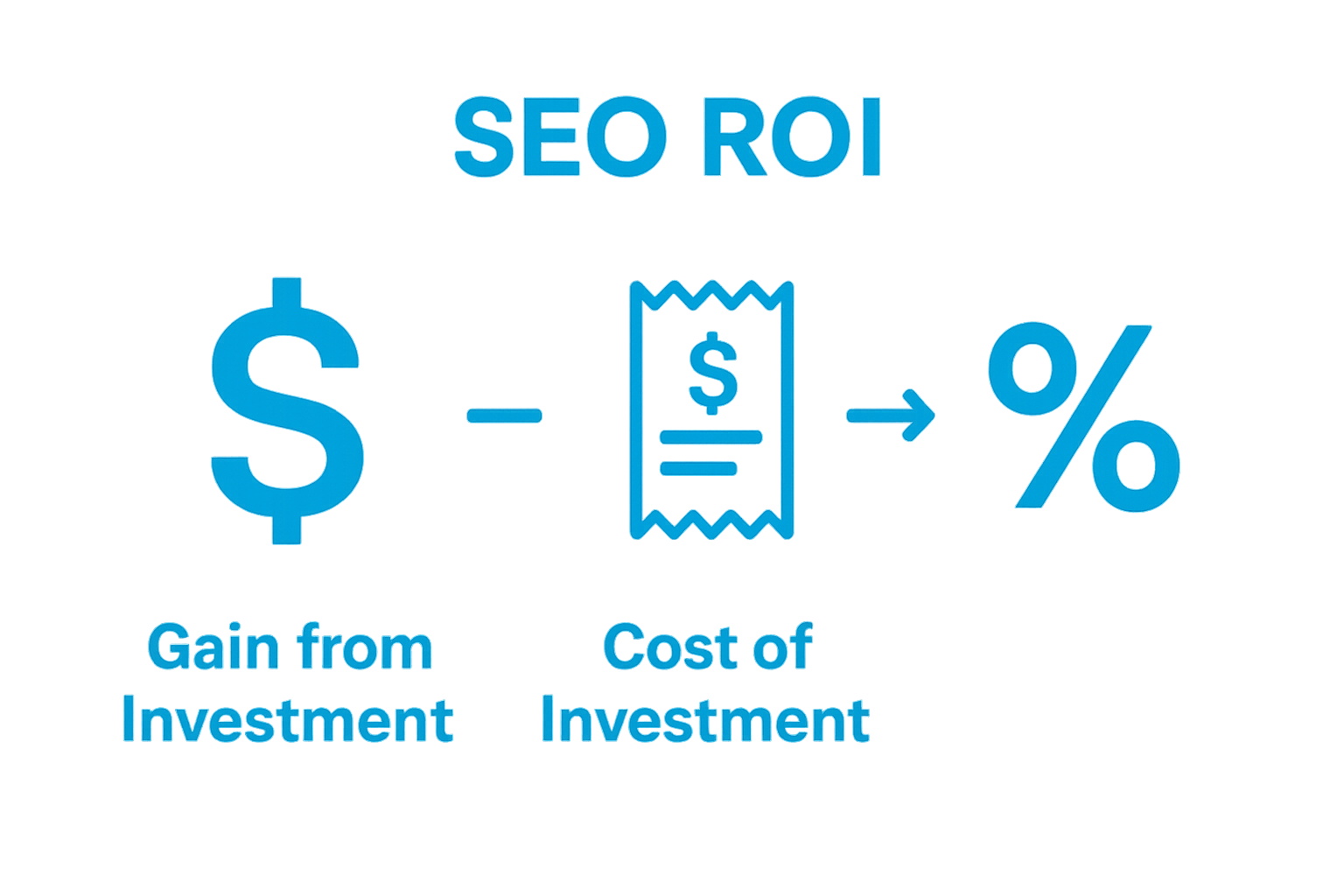Tracking SEO ROI can feel overwhelming when every website click and visitor seems like a moving target. But smart marketers know that businesses using clear, measurable SEO goals see up to 50 percent more predictable revenue growth compared to those who just chase traffic. Here’s what gets surprising—most companies focus on increasing page views, yet the real payoff hides in tracking actual sales and conversions from organic search.
Table of Contents
- Step 1: Define Your SEO Goals And Objectives
- Step 2: Establish Key Performance Indicators (KPIs)
- Step 3: Implement Tracking Tools And Software
- Step 4: Analyze Traffic And Conversion Data
- Step 5: Calculate Your ROI Using The Formula
- Step 6: Adjust Strategies Based On Insights
Quick Summary
| Key Point | Explanation |
|---|---|
| 1. Define SMART SEO Goals | Set Specific, Measurable, Achievable, Relevant, and Time-bound objectives to track meaningful SEO results. |
| 2. Establish Relevant KPIs | Choose Key Performance Indicators that directly align with your business goals to measure SEO effectiveness. |
| 3. Implement Accurate Tracking Tools | Utilize software like Google Analytics to ensure you collect comprehensive data on your SEO efforts. |
| 4. Analyze Traffic and Conversions | Focus on organic traffic quality metrics to gain insights into user engagement and real business value. |
| 5. Adjust Strategies Based on Data | Refine SEO strategies continually based on performance analysis to enhance results and adapt to changes. |
Step 1: Define Your SEO Goals and Objectives
Measuring SEO return on investment (ROI) begins with crystal clear goal setting. Without precise objectives, you will struggle to track meaningful results or demonstrate the true value of your search engine optimization efforts. Effective SEO goals must be specific, measurable, achievable, relevant, and time-bound – often referred to as SMART goals.
Starting your SEO ROI measurement journey requires understanding what success looks like for your specific business context. Organizational goals can vary dramatically across industries. A local service business might prioritize generating qualified leads through organic search, while an ecommerce platform could focus on increasing online revenue attributed to search traffic. Learn more about creating targeted SEO strategies that align with your unique business needs.
To define meaningful SEO objectives, begin by examining your broader business strategy. Consider key performance indicators that directly connect search performance to business outcomes. These might include organic traffic volume, conversion rates, keyword ranking improvements, or revenue generated from search referrals. The most impactful SEO goals will create a direct line of sight between search engine visibility and tangible business growth.
When establishing your objectives, concentrate on metrics that demonstrate genuine business impact. Avoid vanity metrics like total website visits or search impressions that don’t translate into meaningful results. Instead, focus on conversion-oriented measurements such as leads generated, sales completed, or customer acquisition costs reduced through organic search performance. This approach ensures your SEO efforts are not just generating traffic, but driving real, measurable business value.
Proper goal setting also involves setting realistic timelines and understanding the incremental nature of SEO performance. Search engine optimization is typically a long-term strategy, so establish benchmarks and milestones that allow for gradual improvement. Track your progress consistently, adjusting strategies as you gain insights into what drives the most significant results for your specific business model.
Step 2: Establish Key Performance Indicators (KPIs)
After defining your SEO goals, the next critical step is establishing precise Key Performance Indicators (KPIs) that will help you track and measure your progress. KPIs transform abstract objectives into concrete, measurable metrics that provide clear insights into your SEO strategy’s effectiveness. Explore advanced SEO reporting techniques to enhance your measurement approach.
The most effective KPIs are those that directly correlate with your business objectives and provide actionable intelligence. For instance, if your goal is increasing online sales, relevant KPIs might include organic conversion rate, revenue generated from organic search, and average order value from search traffic. These metrics go beyond simple vanity measurements like total website visits and instead focus on meaningful business outcomes.
When selecting KPIs, consider both quantitative and qualitative indicators that offer a comprehensive view of your SEO performance. Quantitative metrics might include organic traffic volume, keyword ranking positions, click-through rates, and bounce rates. Qualitative indicators could encompass user engagement metrics, content relevance, and the strategic alignment of search visibility with your brand’s marketing objectives.
To ensure your KPIs remain relevant and meaningful, implement a systematic approach to tracking and analysis. Utilize robust web analytics tools that can provide granular insights into your search performance. Google Analytics, SEMrush, and Ahrefs offer comprehensive dashboards that can help you monitor these critical metrics in real-time. Regular review and adjustment of your KPIs will help you maintain alignment with evolving business goals and search landscape dynamics.
Remember that KPI selection is not a one-size-fits-all process. What works for an ecommerce platform might differ significantly from a B2B service provider’s approach. The key is to develop a nuanced set of indicators that reflect your unique business model, target audience, and strategic objectives. By establishing clear, meaningful KPIs, you create a robust framework for measuring and optimizing your SEO ROI with precision and insight.
Step 3: Implement Tracking Tools and Software
Implementing robust tracking tools and software is the cornerstone of accurately measuring SEO ROI. Without comprehensive tracking mechanisms, your SEO performance analysis becomes little more than educated guesswork. Learn more about advanced rank tracking techniques to elevate your measurement strategy.
Choosing the right tracking tools requires a strategic approach that aligns with your specific business objectives and KPIs. Google Analytics remains the foundational platform for most SEO tracking, offering a comprehensive suite of free tools that provide deep insights into website performance. However, professional SEO professionals often complement this with specialized tools like SEMrush, Ahrefs, or Moz to gain more nuanced performance data.
Effective tracking goes beyond simple traffic measurements. You’ll want to implement tools that can track complex metrics such as conversion rates, user behavior, keyword performance, and revenue attribution. This means configuring advanced tracking parameters that connect your SEO efforts directly to business outcomes. Set up goal tracking in Google Analytics to monitor specific actions like form submissions, product purchases, or key page interactions that demonstrate the tangible impact of your search engine optimization strategies.
Implementation requires careful configuration to ensure accurate data collection. Start by creating custom dashboards that aggregate your most critical KPIs into a single, easily digestible view. Connect your Google Search Console with Google Analytics to gain comprehensive insights into search performance. Additionally, use UTM parameters for all your marketing campaigns to accurately track the source of your website traffic and distinguish between organic search results and other marketing channels.
The most sophisticated tracking approaches integrate multiple data sources to provide a holistic view of SEO performance. This might involve connecting your web analytics with customer relationship management (CRM) systems, sales platforms, and other business intelligence tools. By creating a comprehensive tracking ecosystem, you’ll be able to demonstrate the true value of your SEO efforts in terms of measurable business impact, transforming SEO from a mysterious marketing function to a quantifiable driver of business growth.
To help you quickly compare the pros, cons, and features of key SEO tracking tools, the following table summarizes the main options mentioned in the guide.
| Tool or Software | Primary Purpose | Notable Features |
|---|---|---|
| Google Analytics | Website analytics & traffic tracking | Free, conversion tracking, custom dashboards |
| Google Search Console | Search performance insights | Search queries, crawl errors, impression/click data |
| SEMrush | SEO and competitive analysis | Keyword tracking, site audits, organic traffic data |
| Ahrefs | Backlink & keyword analysis | Organic traffic metrics, SERP tracking, audit tools |
| Moz | SEO performance monitoring | Keyword rankings, on-page optimization, site metrics |
| CRM/Sales Platforms | Revenue attribution & lead tracking | Integration for comprehensive KPI measurement |

Step 4: Analyze Traffic and Conversion Data
Analyzing traffic and conversion data transforms raw numbers into actionable business intelligence that directly demonstrates your SEO strategy’s effectiveness. The goal is not just to collect data, but to extract meaningful insights that drive strategic decision-making. Discover advanced landing page optimization techniques to maximize your conversion potential.
According to research from ResearchGate, sophisticated traffic analysis can predict conversion rates with remarkable accuracy, potentially increasing revenue by over 50%. This underscores the critical importance of moving beyond surface-level metrics and diving deep into your website’s performance data.
Begin by examining organic traffic quality, which goes far beyond simple visitor count. Focus on metrics that indicate genuine user engagement: average time on page, bounce rate, pages per session, and conversion rate from organic search traffic. These indicators reveal whether your SEO efforts are attracting truly interested potential customers, not just random website visitors.
Utilize advanced segmentation in your analytics platform to understand how different traffic sources and user demographics interact with your website. Google Analytics offers powerful segmentation tools that allow you to break down performance by factors like device type, geographic location, user behavior, and traffic source. This granular approach helps you identify which SEO strategies are most effective for specific audience segments.
Converting traffic data into actionable ROI insights requires connecting search performance directly to revenue generation. Map your conversion funnel carefully, tracking how organic search visitors move through different stages of your customer journey. Implement goal tracking that assigns monetary value to specific actions, such as form submissions, product purchases, or content downloads. By establishing clear attribution models, you can demonstrate the precise financial impact of your SEO investments, transforming what was once perceived as an intangible marketing activity into a measurable, strategic business driver.
Step 5: Calculate Your ROI Using the Formula
Calculating SEO Return on Investment (ROI) transforms your analytical efforts into a clear, actionable financial metric that demonstrates the true value of your search engine optimization strategies. The fundamental ROI formula is straightforward: (Gain from Investment – Cost of Investment) / Cost of Investment x 100.
 This calculation provides a percentage that reveals whether your SEO efforts are generating meaningful financial returns.
This calculation provides a percentage that reveals whether your SEO efforts are generating meaningful financial returns.
According to The National Academies Press, accurate ROI calculation requires meticulous tracking of both direct and indirect investment costs. For SEO, this means carefully accounting for expenses such as:
- Content creation costs
- Tools and software subscriptions
- Employee or contractor time
- Link building expenses
- Website optimization investments
The gain from your SEO investment is where nuanced calculation becomes critical. This isn’t just about immediate revenue but includes long-term value generation. Quantify your gains by assigning monetary value to organic search conversions, increased customer lifetime value, reduced customer acquisition costs, and improved brand visibility.
Practical implementation requires a systematic approach. Start by determining the average value of a conversion from organic search. Multiply this by the number of conversions generated through SEO efforts to establish your total gain. Then subtract all associated SEO investment costs. The resulting figure, when divided by total investment costs and multiplied by 100, provides your SEO ROI percentage.
For example, if your SEO efforts generated $50,000 in revenue with $10,000 in total investment, your ROI calculation would be: ($50,000 – $10,000) / $10,000 x 100 = 400% ROI. This means for every dollar invested in SEO, you’re generating $4 in return. Remember that SEO is a long-term strategy, so consistent tracking and periodic recalculation will provide the most accurate representation of your ongoing performance.
Step 6: Adjust Strategies Based on Insights
Adjusting your SEO strategies based on data-driven insights is the critical final step in maximizing your search engine optimization return on investment. Successful strategy refinement requires a combination of analytical rigor and strategic flexibility. Explore advanced content gap analysis techniques to uncover hidden opportunities for improvement.
According to research from arXiv, strategic adjustments should focus on identifying key turning points in your performance metrics. This means looking beyond surface-level data to understand the nuanced shifts in your SEO performance that indicate potential areas for optimization.
The most effective strategy adjustments target three primary areas: content performance, technical SEO, and keyword targeting. Begin by conducting a comprehensive audit of your existing content, identifying pages that are underperforming or have significant potential for improvement. Look for pages with high impressions but low click-through rates, which suggest opportunities to optimize title tags, meta descriptions, and content relevance.
Technical SEO adjustments require a meticulous approach to addressing potential barriers to search performance. Investigate crawl errors, page speed issues, mobile responsiveness, and internal linking structures that might be impeding your website’s search engine visibility. Use tools like Google Search Console and PageSpeed Insights to identify and prioritize technical improvements that can directly impact your search rankings and user experience.
Keyword strategy refinement is an ongoing process of alignment and optimization. Analyze your current keyword performance, identifying high-potential keywords that are generating quality traffic and those that are underperforming. This might involve expanding your keyword targeting, creating more in-depth content around specific search intents, or reallocating resources from low-performing keywords to more promising opportunities. Remember that SEO is an iterative process – what works today may need adjustment tomorrow, so maintain a mindset of continuous learning and strategic adaptation.
Uncover Real SEO ROI: Eliminate Keyword Cannibalization for Accurate Results
Are you struggling to prove the value of your SEO strategies because multiple pages compete for the same keywords? This common challenge, known as keyword cannibalization, can distort your performance data, frustrate your efforts to set clear goals, and make it nearly impossible to track meaningful ROI. If your analytics do not reflect true organic traction or if conversions seem scattered, the root cause might be hidden within your own website structure. Fixing this issue is essential for anyone committed to tracking SEO goals and maximizing measurable business impact, as discussed throughout this guide.
Start making every step of your SEO investment count by identifying and resolving these hidden conflicts. Discover how the #1 Keyword Cannibalization Tool trusted by professional SEOs can empower you to clarify reporting, improve rankings, and connect your KPIs directly to outcomes. Visit RankAligner today and get the actionable clarity you need to accurately measure and grow your SEO ROI. Do not wait until another reporting cycle blurs your results—take control now and unlock accurate, data-driven success.
Frequently Asked Questions
What are the key steps to measure SEO ROI?
To measure SEO ROI, follow these key steps: define your SEO goals, establish key performance indicators (KPIs), implement tracking tools, analyze traffic and conversion data, calculate your ROI using the formula, and adjust strategies based on insights gained.
What metrics should I focus on to measure SEO success?
Focus on metrics that demonstrate genuine business impact, such as organic traffic volume, conversion rates, revenue generated from search referrals, and customer acquisition costs, rather than vanity metrics like total visits.
How do I calculate my SEO ROI?
To calculate SEO ROI, use the formula: (Gain from Investment – Cost of Investment) / Cost of Investment x 100. This will give you a percentage that indicates whether your SEO efforts are generating a financial return.
Why is it important to adjust SEO strategies based on insights?
Adjusting your SEO strategies based on insights allows you to refine your approach, target areas for improvement, and optimize performance. This iterative process ensures that your SEO efforts align with changing business goals and market dynamics.
This table provides a clear summary of the six essential steps to measure SEO ROI, highlighting the core focus and desired outcome of each stage described in the article.
| Step | Focus | Key Outcome |
|---|---|---|
| 1. Define Goals | Set SMART objectives | Clear strategic direction |
| 2. Set KPIs | Select measurable indicators | Track progress and impact |
| 3. Track Tools | Implement analytics & tracking tools | Collect actionable SEO data |
| 4. Analyze Data | Evaluate traffic & conversions | Uncover insights & performance gaps |
| 5. Calculate ROI | Apply ROI formula | Quantify SEO financial impact |
| 6. Adjust | Refine strategies based on insights | Continuous improvement & adaptation |

